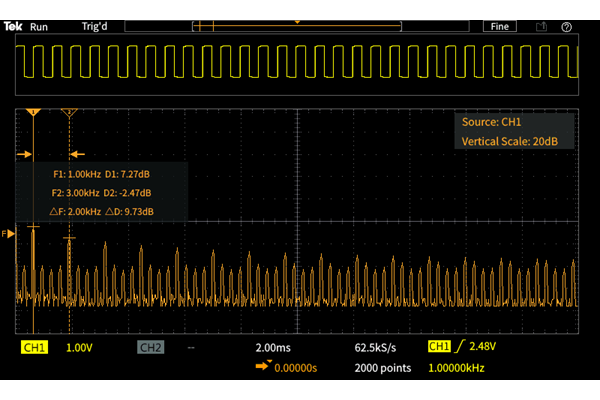Question :
What is FFT (Fast Fourier Transform) math function of an oscilloscope used for?
Answer :
There are a variety of uses that can benefit from viewing the frequency spectrum of a signal. Using the FFT math function on a time domain signal provides the user with frequency domain information and can provide the user a different view of the signal quality, resulting in improved measurement productivity when troubleshooting a device-under-test. Examples include:
- Analyze harmonics in power lines
- Measure harmonic content and distortion in systems
- Characterize noise in DC power supplies
- Test impulse response of filters and systems
- Analyze vibration

Screenshot example of FFT on TBS1000C
More information and examples
Application Note
FFT Applications for TDS Oscilloscopes (application note)
Videos
How to set up an FFT on an oscilloscope
What is Fast Fourier Transform
What is Fast Fourier Transform (FFT)?
The Fast Fourier Transform, commonly known as FFT, is a fundamental mathematical technique used in various fields, including signal processing, data analysis, and image processing. It is a powerful algorithm for transforming time-domain data into its frequency-domain representation, enabling us to analyze the frequency components of a signal or data set. In this section, we will delve into the details of what FFT is, how it works, and its applications.
Understanding FFT
1. Basic Principles
FFT is a more efficient and faster implementation of Discrete Fourier Transform (DFT), which is a mathematical operation used to convert a sequence of time-domain data points into their corresponding frequency-domain representation. FFT algorithms significantly reduce the computational complexity of DFT, making it practical for real-time applications.
2. Time-Domain to Frequency-Domain
At its core, FFT takes a set of discrete time-domain data points, such as a digital signal sampled over time, and decomposes it into a sum of sinusoidal waves of varying frequencies and amplitudes. This transformation allows us to analyze the signal's spectral content, identifying its constituent frequencies and their strengths.
3. Algorithmic Efficiency
FFT algorithm exploits the inherent symmetry in sinusoidal functions to dramatically reduce the number of computations required compared to a naive DFT calculation. This efficiency is especially valuable when processing large datasets or in real-time applications where speed is essential.
Applications of FFT
1. Signal Processing
- Audio Analysis: FFT is used in audio processing to analyze and manipulate audio signals. It's essential in tasks like audio compression, equalization, and pitch detection.
- Image Processing: In image processing, FFT is employed for tasks such as image filtering, compression, and feature extraction.
2. Communication Systems
- Wireless Communication: FFT plays a critical role in modulating and demodulating signals in wireless communication systems like Wi-Fi and cellular networks.
- Spectrum Analysis: It's used to analyze the frequency spectrum of communication signals to ensure efficient utilization of the available bandwidth.
3. Scientific Research
- Physics: FFT is used in various branches of physics to analyze experimental data, such as X-ray crystallography, nuclear magnetic resonance (NMR) spectroscopy, and gravitational wave detection.
- Astronomy: Astronomers use FFT for processing and analyzing data from telescopes and radio telescopes to study celestial objects and phenomena.
4. Data Analysis
- Time Series Analysis: FFT is valuable in time series analysis for identifying periodic patterns and trends in data, such as stock market trends or climate data.
- Vibration Analysis: In mechanical and structural engineering, FFT is employed to analyze vibrations and detect potential issues in machinery.
Conclusion
In summary, Fast Fourier Transform (FFT) is a versatile and powerful mathematical algorithm used for transforming time-domain data into its frequency-domain representation. Its efficiency and widespread applications make it a crucial tool in various fields, from signal processing and communication systems to scientific research and data analysis. Understanding FFT allows researchers and engineers to gain valuable insights into the underlying frequency components of data, facilitating a deeper understanding and better decision-making in a wide range of applications.
This FAQ Applies to:
Product Series: TBS1000C 2 Channel Digital Storage Oscilloscope TBS2000B Digital Storage Oscilloscope 2 Series MSO Portable Mixed Signal Oscilloscope 3 Series MDO Mixed Domain Oscilloscope
Product:
FAQ ID 62251
View all FAQs »

